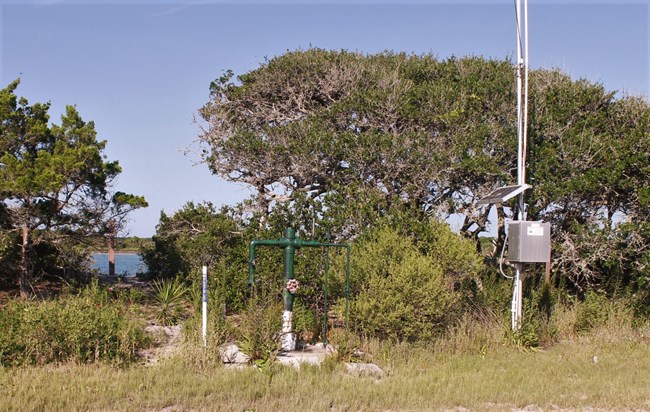
Fort Matanzas, which is located along the coast in St. Johns County, Florida, is underlain by two aquifers- a surficial aquifer and the deeper Floridan Aquifer. The surficial aquifer exists at depths down to about 120 feet and is the main source of drinking water for county residents. It is recharged primarily by rainfall. A layer of clays and mudstones largely separate this aquifer from the Floridan. The Floridan continues to depths of around 360 feet and is where most irrigation water is pumped from. The very extensive Floridan Aquifer is recharged in this region from the lake country of inland Alachua and surrounding counties. This aquifer tends to be more saline than the surficial aquifer closer to the surface. (Keep in mind that freshwater is less dense than saltwater.) The two aquifers are composed of sediments made up mostly of limestone, clay, sand, and dolomite. (Dolomite is a sedimentary rock predominately containing the mineral calcium magnesium carbonate.) Since Florida, geologically speaking (about 25 million years ago), was recently located at the bottom of a warm tropical ocean, it’s not surprising that its bedrock formations are composed largely of the calcium carbonates that once formed the exoskeletons of countless marine organisms that settled to the ocean floor after their deaths. The water table (the uppermost saturated portion of an aquifer) tends to be five to ten feet deep in the county, though it can be found at even shallower depths closer to the coast. If fact, chloride (derived from salty seawater) can be present in relatively high concentrations in coastal areas where the aquifer becomes interconnected with the ocean. Where there is excessive pumping of drinking water near the coast, seawater can be inadvertently drawn in, lending the water a distinctly salty taste. Excessive salt isn’t the only thing that can taint or pollute groundwater. When substances such as household cleaners, fertilizers, pesticides, herbicides, and even pharmaceuticals are improperly disposed of, they may eventually make their way through the ground and into the aquifer. Other sources of potential contamination include: leaking septic systems, landfills, storage tanks, and sewer pipes; illegal waste sites; accidental chemical spills; and runoff of gas, oil, and other fluids from gas stations, roads, and driveways. In order to monitor the quality of groundwater, wells can be sunk and water samples tested. At Fort Matanzas, the park has partnered with the St. Johns River Water Management District to host such a well. It is sunk to a depth of 352 feet and monitors for a suite of physical and chemical parameters such as: conductivity (which gives an indication of salinity), pH (which measures for acidity), total dissolved solids, temperature; and the amount of calcium, magnesium, sodium, chloride, sulfate, iron, arsenic, lead, and copper, among a host of others. |
Last updated: January 22, 2021
